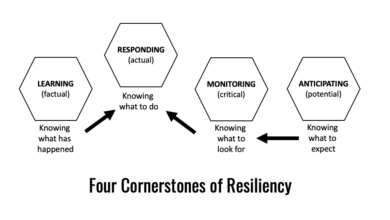
Effective Leadership Communication During COVID-19
Effective leadership communication amid coronavirus crisis is crucial during times of uncertainty and disruption. This exploration delves into strategies for leaders to navigate the complexities of a crisis, focusing on adapting communication styles to various stakeholders, from employees to investors.
The pandemic highlighted the need for clear, empathetic, and timely communication to maintain morale, build trust, and ensure organizational resilience. This post analyzes different communication channels, content strategies, and the importance of transparency and emotional intelligence in fostering a supportive environment.
Leadership Communication Strategies During Crises: Effective Leadership Communication Amid Coronavirus Crisis
Navigating crises effectively requires adaptable and responsive leadership communication. Leaders must not only convey crucial information but also foster trust and resilience within their organizations. This requires a nuanced approach that considers the specific needs and concerns of various stakeholders. Effective communication strategies during crises are paramount to minimizing damage and facilitating a swift and orderly recovery.Leadership communication in crisis situations must prioritize transparency and empathy.
A clear, concise, and consistent message is vital to avoid misinformation and panic. Leaders must actively listen to concerns and address them directly, showing understanding and compassion for those affected. The ultimate goal is to maintain a sense of control and predictability in an otherwise uncertain environment.
Various Leadership Communication Strategies
Different leadership communication strategies are employed during crises. These strategies encompass various approaches, each with its own advantages and limitations. Adaptability and responsiveness are key factors in choosing the right strategy for a given situation. This includes adapting to the changing needs of the situation and ensuring the message resonates with the target audience. For instance, a strategy that works well during the initial stages of a crisis may need to be adjusted as the situation evolves.
Examples of Effective Communication Strategies
Effective crisis communication strategies have been demonstrated by leaders across various industries and situations. For example, during the 2008 financial crisis, some financial institutions communicated clearly and proactively with investors, employees, and the public. Their strategies focused on transparency and honesty, which helped to rebuild trust and maintain stability. On the other hand, companies that failed to communicate effectively during the crisis suffered significant reputational damage and lost investor confidence.
Contrastingly, during the COVID-19 pandemic, some companies excelled in adapting their communication strategies to a rapidly changing situation, while others struggled to maintain consistent communication with their employees and customers.
Crisis Communication Framework
A robust crisis communication framework consists of several key components: proactive planning, rapid response mechanisms, and ongoing communication channels. Proactive planning involves anticipating potential crises and developing communication protocols in advance. Rapid response mechanisms include identifying key stakeholders and establishing communication channels to disseminate information efficiently. Ongoing communication channels ensure continuous updates and address concerns effectively.
Tailoring Communication to Stakeholders
Effective crisis communication requires tailoring strategies to specific stakeholders. Employees need reassurance and guidance on their roles and responsibilities. Customers need clear information about the impact of the crisis on their services and products. Investors require transparency regarding the organization’s financial health and future plans. Different communication channels and messaging formats are crucial to ensure the right message reaches the right audience.
Internal vs. External Communication Strategies
| Characteristic | Internal Audience | External Audience |
|---|---|---|
| Goal | Maintain morale, ensure operational continuity, and build trust | Manage reputation, maintain investor confidence, and rebuild public trust |
| Tone | Empathetic, supportive, and informative | Transparent, honest, and reassuring |
| Content | Detailed updates, instructions, and FAQs | Summary of the situation, company response, and future plans |
| Channels | Intranet, company emails, team meetings | Press releases, social media, investor relations |
Communication Channels in Crisis Situations
Effective communication requires utilizing diverse channels to reach different stakeholders. This includes utilizing a combination of traditional and modern communication methods. These methods must be tailored to the crisis’s nature and the specific needs of the target audience.
- Email: A common method for disseminating information, particularly for internal communication.
- Intranet: A dedicated internal platform to provide updates and resources.
- Social Media: A powerful tool for reaching broad audiences, requiring careful management to prevent misinformation.
- Press Releases: Crucial for communicating with external stakeholders, particularly the media and investors.
- Phone Calls: Direct communication for sensitive or urgent matters, especially when personal interaction is crucial.
Communication Channels and Technologies

Navigating a crisis like the COVID-19 pandemic necessitates a multifaceted communication strategy. Effective communication channels are crucial for maintaining employee morale, disseminating vital information, and fostering a sense of unity and trust during uncertainty. This section delves into the various communication tools available, their strengths and weaknesses, and how to strategically deploy them to maximize impact.Leaders must understand that the choice of communication channel directly impacts the message’s reception and effectiveness.
Selecting the right channel for specific stakeholders and information is paramount to successful crisis management.
Choosing the Right Communication Channel
Selecting the appropriate communication channel for a given message and audience is critical during a crisis. This consideration ensures the message reaches the intended recipients effectively and fosters a sense of transparency. A poorly chosen channel can result in confusion, misinformation, and erode trust.
- Email: Email remains a reliable channel for disseminating broad information, such as policy updates or general announcements. It’s suitable for distributing documents and formal communications. However, its limitations lie in its lack of immediacy and potential for misinterpretation, particularly when conveying complex or sensitive information.
- Instant Messaging (IM): IM platforms provide rapid, real-time communication. These tools are ideal for answering quick questions or addressing immediate concerns. They are particularly helpful for maintaining constant dialogue with employees and team members. However, IM is not ideal for lengthy explanations or detailed information, as the lack of a formal record can create ambiguity.
- Video Conferencing: Video conferencing facilitates face-to-face interaction, even remotely. This is crucial for addressing concerns directly, holding town halls, and providing crucial updates. Its effectiveness lies in its ability to foster empathy and build trust, particularly when delivering sensitive information. However, scheduling conflicts and potential technical difficulties can hinder widespread participation.
- Town Halls: Town halls offer an excellent platform for transparent communication, addressing concerns, and fostering dialogue. They provide an opportunity for Q&A sessions, allowing employees to express their anxieties and concerns. However, organizing and managing a town hall effectively, particularly in a large organization, requires careful planning and logistics.
Comparing Communication Technologies
Different communication technologies offer varying levels of immediacy, formality, and interactivity. The choice of technology should align with the nature of the information being conveyed and the desired level of interaction. For example, a crucial update regarding safety protocols should be communicated via multiple channels (email, video conference, and potentially a town hall) to maximize reach and clarity.
| Communication Channel | Pros | Cons |
|---|---|---|
| Wide reach, record of communication, suitable for broad announcements | Less immediate, potential for misinterpretation, less interactive | |
| Instant Messaging | Fast, real-time interaction, quick responses to queries | Lack of formal record, not suitable for complex information, potential for information overload |
| Video Conferencing | Face-to-face interaction, allows for direct communication and addressing concerns, good for complex updates | Scheduling conflicts, potential technical difficulties, can be challenging for large audiences |
| Town Halls | Direct interaction, fosters dialogue, addresses concerns, build trust | Logistics, time-consuming to organize and manage, can be challenging for large audiences |
Utilizing Digital Tools for Transparency and Trust
Employing digital tools effectively is paramount for maintaining transparency and building trust during a crisis. Leaders should leverage platforms to share updates, provide resources, and encourage two-way communication. This active engagement builds a sense of community and shared purpose. For instance, utilizing social media platforms (internal or external) can provide an additional channel for updates, especially for employees working remotely.
Content and Message Development
Effective communication is paramount during a crisis, especially when dealing with a global pandemic like the coronavirus. Clear, concise, and empathetic messaging builds trust and fosters a sense of shared responsibility. A well-structured communication strategy can mitigate anxieties and help guide individuals and teams through uncertainty.Crises demand more than just factual updates; they require a nuanced understanding of the human element.
Leaders must acknowledge the emotional toll of the crisis while providing clear direction and support. This requires a shift from purely informational communication to a more empathetic and reassuring approach.
Importance of Clear, Concise, and Empathetic Messaging
Clear and concise messaging is crucial for ensuring that information is easily understood and acted upon. Empathetic communication acknowledges the anxieties and concerns of the workforce, demonstrating understanding and concern. This approach fosters a sense of shared experience and promotes trust. Effective messaging helps to alleviate fear and fosters a sense of community, encouraging employees to actively participate in the crisis response.
Examples of Effective Crisis Communication Messages
Numerous organizations have successfully navigated crises by employing effective communication strategies. For instance, during the 2020 COVID-19 pandemic, organizations that prioritized transparent communication and acknowledged the emotional impact of the crisis on their employees often reported higher employee engagement and retention rates. Effective communication included providing clear guidance on safety protocols, readily available resources for employees, and acknowledging the difficulties faced by individuals.
Need for Accurate and Timely Information Dissemination
Accurate and timely information is vital during a crisis. Delaying or withholding information can exacerbate anxieties and distrust. Clear, concise, and consistent communication channels are critical to ensure that employees receive updates promptly and reliably. This includes identifying key communication channels and ensuring that they are actively monitored and updated regularly. Mistakes or misinformation can damage credibility and trust, emphasizing the need for meticulous fact-checking and a structured communication process.
Strategies for Proactively Addressing Concerns and Anxieties
Proactive communication strategies are essential for managing concerns and anxieties. Actively addressing potential concerns and questions demonstrates a commitment to supporting the workforce. This can involve creating dedicated Q&A sessions, holding virtual town halls, or establishing an open communication forum where employees can ask questions and express concerns. These initiatives foster a culture of transparency and trust.
Acknowledging the Human Impact of a Crisis on the Workforce, Effective leadership communication amid coronavirus crisis
Acknowledging the human impact of a crisis is crucial. Leaders should recognize the stress, anxiety, and uncertainty employees experience. This includes providing resources for mental health support, flexible work arrangements, and opportunities for employees to connect with each other. Demonstrating empathy and support fosters a resilient workforce that is better equipped to navigate the challenges of a crisis.
Best Practices for Developing Crisis Communication Content
| Category | Description |
|---|---|
| Clarity and Conciseness | Use simple language, avoid jargon, and get straight to the point. Ensure all communication is easily understandable by all stakeholders. |
| Empathy and Support | Acknowledge the emotional impact of the crisis on employees and offer support mechanisms. Emphasize compassion and understanding. |
| Accuracy and Timeliness | Ensure all information is accurate and up-to-date. Provide updates promptly and consistently. |
| Transparency and Honesty | Be open and honest about the situation, even if it’s challenging. Address concerns directly and provide context. |
| Accessibility and Inclusivity | Use multiple communication channels to ensure all employees can access information. Consider diverse communication styles and preferences. |
| Proactive Communication | Anticipate potential questions and concerns, and address them proactively. |
Building Trust and Transparency
Navigating a crisis, especially one as unprecedented as the COVID-19 pandemic, demands a profound shift in leadership communication. Simply disseminating information isn’t enough; leaders must actively build trust and transparency with their stakeholders. This involves demonstrating genuine empathy, actively listening to concerns, and proactively managing misinformation. A transparent and trustworthy approach not only fosters confidence but also empowers stakeholders to cope with the crisis effectively.Effective leadership communication during a crisis hinges on the ability to connect with stakeholders on an emotional level.
This requires acknowledging the anxieties, fears, and uncertainties inherent in the situation. Building trust and transparency becomes the bedrock upon which effective crisis response is built, empowering stakeholders to feel supported and understood.
Importance of Empathy and Active Listening
Empathy and active listening are crucial components of effective crisis communication. Leaders who demonstrate empathy acknowledge the emotional toll of the crisis on their stakeholders, validating their feelings without minimizing the situation. Active listening involves not just hearing but also understanding the concerns and perspectives of stakeholders, including employees, customers, and the broader community. This involves creating channels for feedback, responding to concerns promptly and thoughtfully, and demonstrating a willingness to understand diverse viewpoints.
Strategies for Proactively Addressing Rumors and Misinformation
Addressing rumors and misinformation is a critical aspect of crisis communication. Proactive strategies involve anticipating potential rumors, developing accurate and accessible information, and communicating it through trusted channels. Leaders must be prepared to correct false narratives swiftly and effectively, emphasizing factual data and evidence-based communication. Social media monitoring and engagement are key in proactively addressing rumors and misinformation.
This involves monitoring social media platforms for circulating rumors and responding with accurate information, fostering an environment of trust and reducing the spread of misinformation.
Comparison of Effective and Ineffective Communication Styles
Effective leaders during a crisis communicate with clarity, honesty, and empathy. They acknowledge the anxieties and concerns of their stakeholders and address them transparently. They are proactive in addressing rumors and misinformation, ensuring accurate information is readily available. Conversely, ineffective leaders often exhibit a lack of empathy, providing vague or contradictory information. They may avoid addressing concerns, allowing rumors to fester, and potentially causing further anxiety and mistrust.
Strategies for Fostering a Culture of Open Communication
Fostering a culture of open communication involves creating channels for two-way communication. Leaders should encourage questions, feedback, and concerns, creating safe spaces for stakeholders to express their thoughts and anxieties. This can be achieved through town hall meetings, online forums, surveys, and other methods. Establishing clear communication protocols, outlining who is responsible for communicating what, and when, is also essential.
Methods of Addressing Stakeholder Concerns
| Concern Category | Methods of Addressing Concerns |
|---|---|
| Financial Concerns | Regular updates on financial performance, support programs for affected stakeholders, transparency about resource allocation. |
| Health and Safety Concerns | Clear guidelines and protocols for safety measures, providing access to reliable health information, and actively addressing concerns about resource availability. |
| Operational Concerns | Providing clear communication about operational changes, explaining the impact on stakeholders, and offering support for affected individuals or departments. |
| Emotional and Psychological Concerns | Acknowledging the emotional impact of the crisis, providing access to mental health resources, and fostering a supportive environment. |
Adapting Communication in a Dynamic Environment
Navigating a crisis requires more than a well-crafted initial message. Effective leadership communication demands adaptability. Circumstances evolve rapidly, necessitating adjustments in strategies, channels, and content to maintain trust and effectiveness. This adaptability is crucial to ensuring the message resonates with the audience, irrespective of the crisis’s evolving nature.Effective crisis communication is not a static exercise; it’s a dynamic process that requires constant monitoring and adjustment.
Leaders must be prepared to pivot their approach as the situation unfolds. This adaptability allows them to respond to the changing needs of their stakeholders and ensure they receive the most pertinent and accurate information.
Importance of Adapting Communication Strategies
Adapting communication strategies in response to changing circumstances is vital for maintaining credibility and trust. Failure to adapt can lead to miscommunication, confusion, and potentially damage the organization’s reputation. A leader’s ability to recognize shifts in the crisis and adjust their communication approach demonstrates a commitment to transparency and a proactive response to the evolving situation.
Examples of Communication Strategy Adjustments
During the COVID-19 pandemic, many organizations adjusted their communication strategies. Some shifted from in-person briefings to virtual town halls. Others prioritized frequent updates via social media, email, and text messaging to keep employees and stakeholders informed about safety measures and business continuity plans. The critical factor was responsiveness to the changing nature of the pandemic and the shift to a remote workforce.
Adjustments included clarifying policies, adapting to different communication preferences, and offering resources to support remote work.
Need for Flexibility and Responsiveness
Flexibility and responsiveness are paramount in crisis communication. Leaders must be prepared to alter their communication plans in real-time based on the evolving situation. This includes adjusting the frequency of updates, the channels used, and the specific information conveyed. Rapid response and quick adjustments demonstrate a proactive approach, emphasizing a commitment to addressing the evolving needs of the public.
Monitoring and Evaluating Communication Effectiveness
Monitoring and evaluating the effectiveness of communication strategies is essential. Leaders should track metrics such as engagement rates, feedback received, and overall sentiment. Regular assessment allows for adjustments and improvements, ensuring the communication strategy remains relevant and impactful. By assessing the impact of the communication strategies, organizations can gain insights into areas that need improvement.
Providing Ongoing Updates and Information
Ongoing updates and information are crucial during a crisis. Providing regular updates demonstrates transparency and commitment to keeping stakeholders informed. This includes addressing concerns, providing factual information, and acknowledging uncertainty when necessary. Regular, consistent updates build trust and reduce anxiety.
Adapting Communication Based on Crisis Stages
| Crisis Stage | Communication Focus | Communication Channels | Content Examples ||—|—|—|—|| Early Stage (Emergence): | Establish the scope of the crisis; clarify potential impact; assure stakeholders of readiness. | Official website, press releases, social media. | “Statement of concern”, “Preliminary assessment”, “Emergency response plans”. || Escalation Stage: | Communicate the impact and actions taken to mitigate; clarify procedures and processes; emphasize support and resources.
| Multiple channels: website, email, town halls, social media, text alerts. | “Updates on the situation”, “Employee assistance programs”, “Revised safety protocols”. || Resolution Stage: | Summarize the crisis response; acknowledge lessons learned; look forward to recovery. | Official website, internal communications, thank-you notes, social media. | “Report on response”, “Recommendations for improvement”, “Recovery plan overview”.
|
Emotional Intelligence and Leadership

Navigating a crisis requires more than just strategy and planning; it demands a deep understanding of human emotions and the ability to connect with stakeholders on a personal level. Emotional intelligence (EQ) plays a crucial role in crisis communication, enabling leaders to build trust, manage stress, and foster resilience within their teams and the broader community. This is particularly critical during times of uncertainty and fear, where the emotional impact can be profound.Effective leadership during a crisis hinges on the capacity to recognize, understand, and manage one’s own emotions, while simultaneously empathizing with the feelings of others.
This nuanced approach is vital for building strong relationships, maintaining morale, and ultimately driving positive outcomes. A leader with high EQ can inspire confidence and motivate individuals to work collaboratively toward common goals.
The Role of Emotional Intelligence in Crisis Communication
Emotional intelligence is paramount in crisis communication. It allows leaders to adapt their communication style to the prevailing emotional climate, recognizing the anxieties and concerns of stakeholders. Leaders with high EQ are able to convey empathy, reassurance, and a sense of hope, which are critical for building trust and mitigating fear. A measured and empathetic response fosters a more constructive dialogue, enabling more effective problem-solving and decision-making.
Managing Emotions and Demonstrating Empathy During a Crisis
Managing one’s own emotions is crucial in a crisis. Leaders should actively acknowledge their own feelings, anxieties, and stress. However, they must also ensure that their emotional responses do not undermine the overall communication strategy. Empathy is essential. Leaders must actively listen to the concerns of stakeholders, validate their emotions, and respond with compassion and understanding.
This proactive approach helps create a sense of shared experience and promotes a more supportive environment. For example, acknowledging the uncertainty and fear felt by employees can help alleviate those anxieties.
Examples of Leaders Who Demonstrated Emotional Intelligence During Crises
Numerous leaders have effectively demonstrated emotional intelligence during crises. Nelson Mandela, known for his exceptional communication and empathy, skillfully navigated the complexities of apartheid in South Africa, demonstrating the power of emotional intelligence in resolving profound social divisions. During the COVID-19 pandemic, some CEOs demonstrated resilience by maintaining transparent communication with their employees, acknowledging their anxieties, and providing support.
These examples highlight the tangible impact of emotional intelligence in crisis management.
Addressing the Emotional Needs of Stakeholders
Recognizing and addressing the emotional needs of stakeholders is essential for effective crisis management. This involves actively listening to concerns, offering reassurance, and providing resources for support. Leaders must create avenues for open communication, ensuring that stakeholders feel heard and understood. This might include dedicated forums, online platforms, or direct contact channels.
Best Practices for Leading Through Challenging Times
Leading through challenging times requires a proactive approach that focuses on empathy, transparency, and clear communication. Leaders should model resilience and composure, demonstrating a commitment to addressing the situation effectively. This includes actively seeking diverse perspectives, fostering inclusivity, and promoting collaboration among stakeholders. For example, during a natural disaster, clear communication regarding safety protocols and available resources is crucial to maintaining order and ensuring stakeholder safety.
Impact of Emotional Intelligence on Effective Leadership Communication
| Aspect of Emotional Intelligence | Impact on Leadership Communication |
|---|---|
| Self-awareness | Leaders understand their own emotions and how they impact their communication, allowing for more appropriate and effective responses. |
| Self-regulation | Leaders maintain composure and manage their emotions effectively, preventing communication breakdowns and promoting a sense of stability. |
| Motivation | Leaders demonstrate enthusiasm and commitment to their message, fostering inspiration and motivation among stakeholders. |
| Empathy | Leaders understand and share the feelings of stakeholders, creating a sense of connection and trust, and leading to better communication outcomes. |
| Social Skills | Leaders effectively build relationships and navigate complex social situations, promoting open communication channels and effective conflict resolution. |
Last Word
In conclusion, effective leadership communication during a crisis like the COVID-19 pandemic demands adaptability, empathy, and a deep understanding of different stakeholder needs. Leaders who prioritize clear, consistent, and timely communication build trust, navigate challenges, and ultimately foster resilience within their organizations. The key takeaways offer practical strategies to enhance crisis management and build stronger, more resilient teams.





